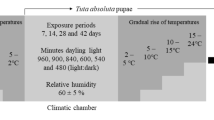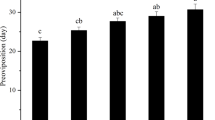Abstract
Temperature is one of the main factors affecting insect populations. The models used for studying the effect of temperature on insects are usually based on insect developmental rates. However, life table parameters such as the (intrinsic) population rate of increase (r m), which reflect the overall effect of temperature on the development, reproduction, and survival of the insect, should also be considered. The leaf miner Tuta absoluta (Lepidoptera: Gelechiidae) is an invasive tomato pest across several regions of the world with its range currently expanding because of its spread into the Middle East and Asia. Thus, this study aimed to assess the impact of temperature on T. absoluta and to determine the thermal requirements for this pest based on life table parameters. For this purpose, bioassays of the development and reproduction of T. absoluta under constant temperatures (17, 22, 26, 28, 30, and 33 °C) were performed. The thermal requirements of T. absoluta were assessed from r m. We found that the immature mortality of T. absoluta was lowest at 28 and 30 °C and highest at 17 °C. The optimum temperature for T. absoluta was 30 °C with upper and lower developmental thresholds of 34.6 and 14 °C, respectively. These thermal requirements were different from those that can be estimated from the rate of insect development. The results of this study would be helpful toward developing phenological, spatial, and temporal distribution models for T. absoluta and toward determining optimal management strategies for this pest species.





Similar content being viewed by others
References
Bale JS (2002) Insects and low temperatures: from molecular biology to distributions and abundance. Philos Trans R Soc B 357:849–862
Balzan MV, Moonen AC (2012) Management strategies for the control of Tuta absoluta (Lepidoptera: Gelechiidae) damage in open-field cultivations of processing tomato in Tuscany (Italy). EPPO Bull 42:217–225
Barrientos ZR, Apablaza HJ, Norero AS, Estay PP (1998) Temperatura base y constante térmica de desarrollo de la polilla del tomate, Tuta absoluta (Lepidoptera: Gelechiidae). Cienc Investig Agrar 25:133–137
Benkova I, Volf P (2007) Effect of temperature on metabolism of Phlebotomus papatasi (Diptera : Psychodidae). J Med Entomol 44:150–154
Betancourt CM, Scatoni IB, Rodríguez JJ (1996) Influencia de la temperatura sobre la reproducción y el desarrollo de Scrobipalpuloides absoluta (Meyrick) (Lepidoptera: Gelechiidae). Rev Bras Biol 56:661–670
Briere JF, Pracos P, Le Roux AY, Pierre JS (1999) A novel rate model of temperature-dependent development for arthropods. Environ Entomol 28:22–29
Carey JR (1993) Applied demography for biologists, with special emphasis on insects. Oxford University Press, UK
Chermiti B, Abbes K, Aoun M, Othmane SB, Ouhibi M, Gamoon W, Kacem S (2009) First Estimate of the damage of Tuta absoluta (Povolny) (Lepidoptera: Gelechiidae) and evaluation of the efficiency of sex pheromone traps in greenhouses of tomato crops in the Bekalta region, Tunisia. Afr J Plant Sci Biotechnol 3:49–52
Coelho MCF, França FH (1987) Biologia, quetotaxia da larva e descrição da traça-do-tomateiro. Pesquisa Agropecuaria Brasileira 22:129–135
Colinet H, Lalouette L, Renault D (2011) A model for the time–temperature–mortality relationship in the chill-susceptible beetle, Alphitobius diaperinus, exposed to fluctuating thermal regimes. J Therm Biol 36:403–408
Cui X, Wan F, Xie M, Liu T (2008) Effects of heat shock on survival and reproduction of two white fly species, Trialeurodes vaporariorum and Bemisia tabaci biotype B. J Insect Sci 8:24. doi:10.1673/031.008.2401
Cuthbertson AGS, Mathers JJ, Blackburn LF, Korycinska A, Luo W, Jacobson RJ, Northing P (2013) Population development of Tuta absoluta (Meyrick) (Lepidoptera: Gelechiidae) under simulated UK glasshouse conditions. Insects 4:185–197. doi:10.3390/insects4020185
Damos P, Savopoulou-Soultani M (2012) Temperature driven models for insect development and vital thermal requirements. Psyche 2012:1–13. doi:10.1155/2012/123405
Denlinger DL, Lee RE Jr (2010) Low temperature biology of insects. Cambridge University Press, Cambridge
Desneux N, Wajnberg E, Wyckhuys KAG, Burgio G, Arpaia S, Narváez-Vasquez CA, González-Cabrera J, Catalán Ruescas D, Tabone E, Frandon J, Pizzol J, Poncet C, Cabello T, Urbaneja A (2010) Biological invasion of European tomato crops by Tuta absoluta: ecology, history of invasion and prospects for biological control. J Pest Sci 83:197–215
Desneux N, Luna MG, Guillemaud T, Urbaneja A (2011) The invasive South American tomato pinworm, Tuta absoluta, continues to spread in Afro-Eurasia and beyond: the new threat to tomato world production. J Pest Sci 84:403–408
Estay SA, Lima M, Labra FA (2009) Predicting insect pest status under climate change scenarios: combining experimental data and population dynamics modeling. J Appl Entomol 133:491–499
Galdino TVS, Picanço MC, Morais EGF, Silva NR, Silva GA, Lopes MC (2011) Bioassay method for toxicity studies of insecticide formulations to Tuta absoluta (Meyrick, 1917). Ciência e Agrotecnologia 35:869–877
Guedes RNC, Picanço MC (2012) The tomato borer Tuta absoluta in South America: pest status, management and insecticide resistance. EPPO Bull 42:211–216
Guillemaud T, Blin A, Le Goff I, Desneux N, Reyes M, Tabone E, Tsagkarakou A, Niño L, Lombaert L (2015) The tomato borer, Tuta absoluta, invading the Mediterranean Basin, originates from a single introduction from Central Chile. Sci Rep 5:8371. doi:10.1038/srep08371
Harbi A, Abbes K, Chermiti B (2012) Evaluation of two methods for the protection of tomato crops against the tomato leafminer Tuta absoluta (Meyrick) under greenhouses in Tunisia. EPPO Bull 42:317–321. doi:10.1111/epp.2576
Harrington R, Fleming R, Woiwood IP (2001) Climate change impacts on insect management and conservation in temperate regions: can they be predicted? Agric For Entomol 3:233–240
James SS, Pereira RM, Vail KM, Ownley BH (2002) Survival of imported fire ant (Hymenoptera: Formicidae) species subjected to freezing and near-freezing temperatures. Environ Entomol 31:127–133
Ju RT, Wang F, Li B (2011) Effects of temperature on the development and population growth of the sycamore lace bug, Corythucha ciliata. J Insect Sci 11:16. doi:10.1673/031.011.0116
Kang L, Chen B, Wei JN, Liu TX (2009) Roles of thermal adaptation and chemical ecology in Liriomyza distribution and control. Annu Rev Entomol 54:127–145
Koda K, Nakamura H (2012) Effects of temperature on the development and survival of an endangered butterfly, Lycaeides argyrognomon (Lepidoptera: Lycaenidae) with estimation of optimal and threshold temperatures using linear and nonlinear models. Entomol Sci 15:162–170
Krebs CJ (1994) Ecology: the experimental analysis of distribution and abundance. Harper Collins, New York
Lactin DJ, Holliday NJ, Johnson DL, Craigen R (1995) Improved rate model of temperature-dependent development by arthropods. Environ Entomol 24:68–75
Lalouette L, Williams CM, Hervant F, Sinclair BJ, Renault D (2011) Metabolic rate and oxidative stress in insects exposed to low temperature thermal fluctuations. Comp Biochem Physiol A 158:229–234
Lam WKF, Pedigo LP, Hinz PN (2001) Population dynamics of bean leaf beetles (Coleoptera: Chrysomelidae) in Central Iowa. Environ Entomol 30:562–567
Liu JF, Yang MF, Hu JF, Han C (2015) Effects of temperature on development and survival of Orthopygia glaucinalis (Lepidoptera: Pyralidae) reared on Platycarya strobilacea. J Econ Entomol 108:504–514
Luna MG, Pereyra PC, Coviella CE, Nieves E, Savino V, Gervassio NGS, Luft E, Virla E, Sánchez NE (2015) Potential of biological control agents against Tuta absoluta (Lepidoptera: Gelechiidae): current knowledge in Argentina. Fla Entomol 98:489–494
Marchioro CA, Foerster LA (2011) Development and survival of the diamondback moth, Plutella xylostella (L.) (Lepidoptera: Yponomeutidae) as a function of temperature: effect on the number of generations in tropical and subtropical regions. Neotrop Entomol 40:533–541
Mironidis GK, Savopoulou-Soultani M (2008) Development, survivorship, and reproduction of Helicoverpa armigera (Lepidoptera: Noctuidae) under constant and alternating temperatures. Environ Entomol 37:16–28
Neven LG (2000) Physiological responses of insects to heat. Postharvest Biol Technol 21:103–111
Nigro RG, Campos MCC, Perondini ALP (2007) Temperature and the progeny sex-ratio in Sciara ocellaris (Diptera, Sciaridae). Genet Mol Biol 30:152–158
Orang FS, Aghdam HR, Abbasipour H, Askarianzadeh A (2014) Effect of temperature on developmental rate of Sesamia cretica (Lepidoptera: Noctuidae) immature stages. J Insect Sci 14(197):2014. doi:10.1093/jsesa/leu059
Park HH, Ahn JJ, Park CG (2014) Temperature-dependent development of Cnaphalocrocis medinalis Guenée (Lepidoptera: Pyralidae) and their validation in semi-field condition. J Asia Pac Entomol 17:83–91
Picanço MC, Silva DJH, Leite GLD, Mata AC, Jham GN (1995) Intensidade de ataque de Scrobipalpula absoluta (Meyrick, 1917) (Lepidoptera: Gelechiidae) ao dossel de três espécies de tomateiro. Pesquisa Agropecuaria Brasileira 30:429–433
Ponti L, Gilioli G, Biondi A, Desneux N, Gutierrez AP (2015a) Physiologically based demographic models streamline identification and collection of data in evidence-based pest risk assessment. EPPO Bull 45:157–328. doi:10.1111/epp.12224
Ponti L, Gutierrez AP, Altieri MA (2015b) Holistic approach in invasive species research: the case of the tomato leaf miner in the Mediterranean Basin. Agroecol Sustain Food Syst 39:436–468
Price PW (1997) Insect ecology. Wiley, New York
Roy M, Brodeur J, Cloutier C (2003) Effect of temperature on intrinsic rates of natural increase (r m ) of a coccinellid and its spider mite prey. Biocontrol 48:57–72
SAS Institute (2008) The SAS system for Windows, version 9.2. SAS Institute, Cary
Sgolastra F, Kemp WP, Buckner JS, Pitts-Singer TL, Maini S, Bosch J (2011) The long summer: pre-wintering temperatures affect metabolic expenditure and winter survival in a solitary bee. J Insect Physiol 57:1651–1659
Silva DJH, Vale FXR (2007) Tomate: tecnologia e produção. Suprema Gráfica e Editora Ltda, Viçosa
Silva GA, Picanço MC, Bacci L, Crespo ALB, Rosado JF, Guedes RNC (2011) Control failure likelihood and spatial dependence of insecticide resistance in the tomato pinworm, Tuta absoluta. Pest Manag Sci 67:913–920
Southwood TRE, Henderson PA (2000) Ecological methods. Blackwell Science, Oxford
Sreedevi G, Prasad YG, Prabhakar M, Rao GR, Vennila S, Venkateswarlu B (2013) Bioclimatic thresholds, thermal constants and survival of Mealybug, Phenacoccus solenopsis (Hemiptera: Pseudococcidae) in response to constant temperatures on Hibiscus. PLoS One 8:e75636. doi:10.1371/journal.pone.0075636
Systat Software Inc (2002) TableCurve 2D, version 5.01. Systat Software Inc, San Jose
Thomson LJ, Macfadyen S, Hoffmann AA (2010) Predicting the effects of climate change on natural enemies of agricultural pests. Biol Control 52:296–306
Tonnang HEZ, Mohamed SA, Khamis F, Ekesi S (2015) Correction: identification and risk assessment for worldwide invasion and spread of Tuta absoluta with a focus on Sub-Saharan Africa: Implications for phytosanitary measures and management. PLoS One 10(9):e0138319. doi:10.1371/journal.pone.0138319
Urbaneja A, González-Cabrera J, Arnó J, Gabarra R (2012) Prospects for the biological control of Tuta absoluta in tomatoes of the Mediterranean basin. Pest Manag Sci 68:1215–1222. doi:10.1002/ps.3344
Van Damme V, Berkvens N, Moerkens R, Berckmoes E, Wittemans L, De Vis R, Casteels H, Tirry L, De Clercq P (2015) Overwintering potential of the invasive leafminer Tuta absoluta (Meyrick) (Lepidoptera: Gelechiidae) as a pest in greenhouse tomato production in Western Europe. J Pest Sci 88:533–541
Vargas RI, Walsh WA, Kanehisa DT, Jang EB, Armstrong JW (1997) Demography of four Hawaiian fruit flies (Diptera: Tephritidae) reared at five constant temperatures. Ann Entomol Soc Am 90:162–168
Vercher R, Calabuig A, Felipe C (2010) Ecología, muestreos y umbrales de Tuta absoluta (Meyrick). Phytoma España 217:23–26
Wallner WE (1987) Factors affecting insect population dynamics: differences between outbreak and non-outbreak species. Ann Rev Entomol 32:317–340
Zappalà L, Biondi A, Alma A, Al-Jboory IJ, Arnò J, Bayram A, Chailleux A, El-Arnaouty A, Gerling D, Guenaoui Y, Shaltiel-Harpaz L, Siscaro G, Stavrinides M, Tavella L, Aznar RV, Urbaneja A, Desneux N (2013) Natural enemies of the South American moth, Tuta absoluta, in Europe, North Africa and Middle East, and their potential use in pest control strategies. J Pest Sci 86:635–647
Zheng FS, Du YZ, Wang ZJ, Xu JJ (2008) Effect of temperature on the demography of Galerucella birmanica (Coleoptera: Chrysomelidae). Insect Sci 15:375–380
Acknowledgments
The authors would like to thank the National Council for Scientific and Technological Development (Conselho Nacional de Desenvolvimento Científico e Tecnológico—CNPq), the Brazilian Federal Agency for the Support and Evaluation of Graduate Education (Coordenação de Aperfeiçoamento de Pessoal de Ensino Superior—CAPES), and the Minas Gerais State Foundation for Research Aid (Fundação de Amparo à Pesquisa do Estado de Minas Gerais—FAPEMIG) for the financial support they provided.
Author information
Authors and Affiliations
Corresponding author
Ethics declarations
Conflict of interest
The authors declare that they have no conflict of interest.
Additional information
Communicated by N. Desneux.
Rights and permissions
About this article
Cite this article
Martins, J.C., Picanço, M.C., Bacci, L. et al. Life table determination of thermal requirements of the tomato borer Tuta absoluta . J Pest Sci 89, 897–908 (2016). https://doi.org/10.1007/s10340-016-0729-8
Received:
Revised:
Accepted:
Published:
Issue Date:
DOI: https://doi.org/10.1007/s10340-016-0729-8




